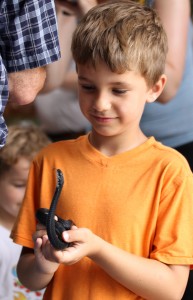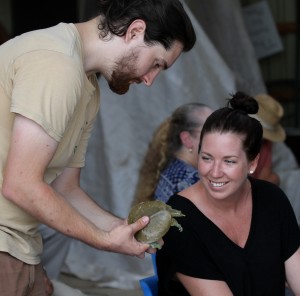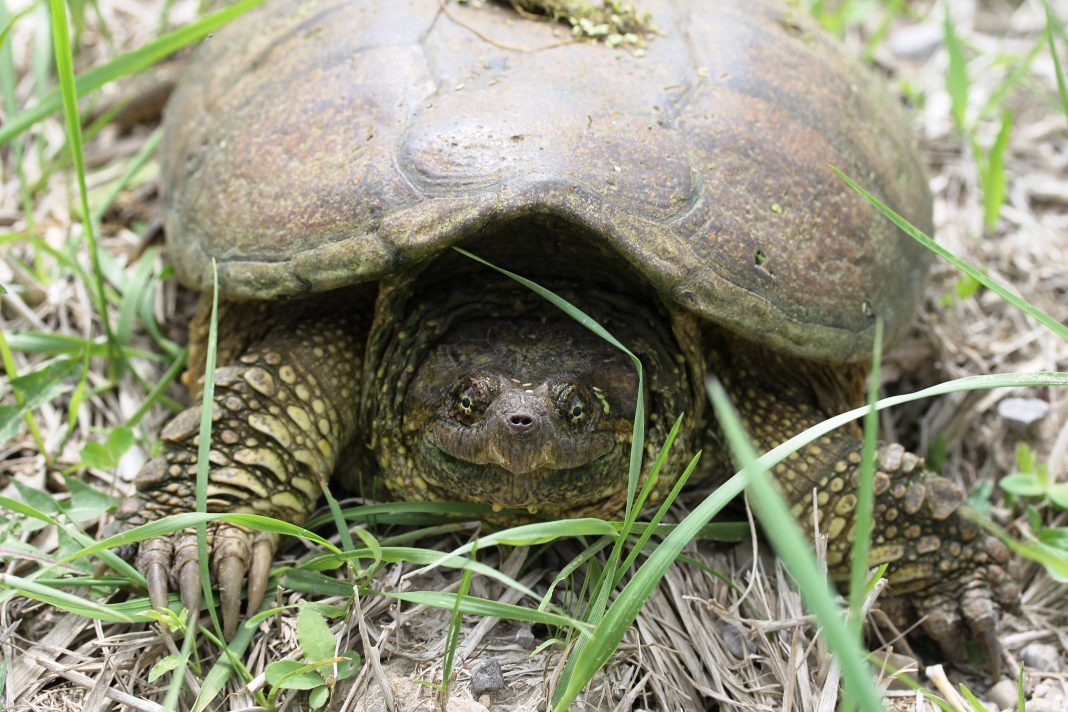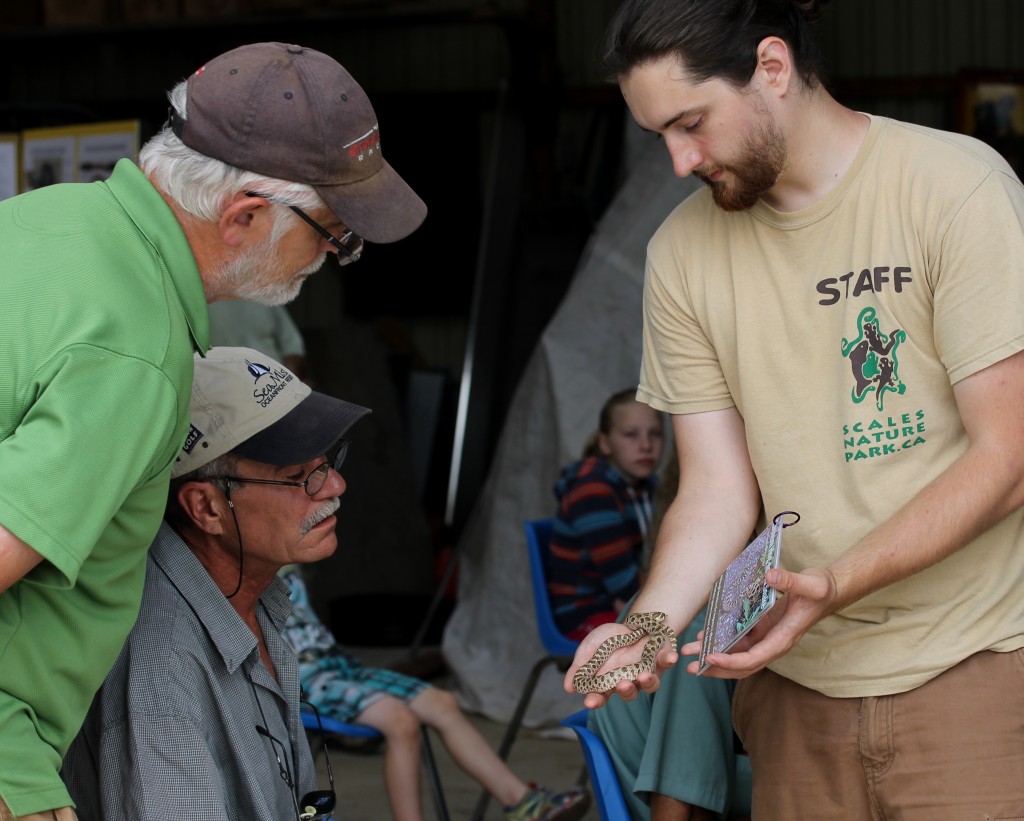 Over 30 people came out to learn about reptiles at risk in Huron County Sunday July 19th at the Hullett Provincial Conservation Area as Scales Nature Park staff presented an interactive hands-on program. The excellent two and a half hour advanced workshop taught local residents how to identify reptile species, learn about their biology and conservation status, and identify threats to reptiles in Ontario. The workshop was a great opportunity to learn more about species you and your kids can find in your own backyard, learn about ways you can help them, and overcome your fears (if you have any) by holding the animals. Although the workshop was an advanced level course, some keen kids were there to get a chance to learn about their local pond turtle and hold their favorite snake. Over a hundred dollars was raised for the construction of the Georgian Bay Turtle Hospital- a much needed hospital for turtles that is being built outside of Orillia.
Over 30 people came out to learn about reptiles at risk in Huron County Sunday July 19th at the Hullett Provincial Conservation Area as Scales Nature Park staff presented an interactive hands-on program. The excellent two and a half hour advanced workshop taught local residents how to identify reptile species, learn about their biology and conservation status, and identify threats to reptiles in Ontario. The workshop was a great opportunity to learn more about species you and your kids can find in your own backyard, learn about ways you can help them, and overcome your fears (if you have any) by holding the animals. Although the workshop was an advanced level course, some keen kids were there to get a chance to learn about their local pond turtle and hold their favorite snake. Over a hundred dollars was raised for the construction of the Georgian Bay Turtle Hospital- a much needed hospital for turtles that is being built outside of Orillia.
Reptiles continue to be one of the most persecuted groups of animals on the planet because of negative stereotypes and myths. Snakes in particular are still killed daily with wanton disregard for their conservation status, likely because they are perceived as a threat. Sixteen of our seventeen species of snakes in Ontario are non—venomous, which means they are more harmless than a piece of loose-leaf paper (I use this analogy because I’ve had hundreds of snake bites- of which one required a Band-Aid, and dozens of paper cuts- which hurt more and always required a Hello Kitty Band-Aid).
Our one venomous species (NOT found in Huron County), the adorable Threatened massasauga rattlesnake, packs about as much punch in its venom as a jellyfish in an arm-wrestling competition. There have only been two deaths by a massasagua rattlesnake in Ontario in the last 200 years (the last death was a little girl who was bitten over 50 years ago and not taken to the hospital). When confronted, the small rattlesnake is more scared of you, than you it, and will try to retreat if it can’t scare you off with its rattle. The majority of bites each year (averaging between 4 and 12/year) are usually the result of people in flip flops stepping on them (they don’t like being stepped on) and intoxicated male 20 something year-olds picking them up with a false sense of bravado (they also don’t like drunk people too much). One in 3 bites are ‘dry’, meaning there is no envenomation, so even if you got a nip there might not be any venom in your body. If there is envenomation, calmly go to the hospital. You’re more likely to die in a car accident on the way to the hospital than from the bite, so buckle up! 
Turtles also face persecution, especially the snapping turtle. This usually docile turtle, listed as a Species at Risk of extinction, has one of the worst reputations known to reptiles. Sure, they can be snappy on land (because of their tiny belly shell that does little more than a bikini to protect them from predators). But in the water, they’re as gentle as sea cows as they munch away at lily pads and glide along the bottom of ponds. The force of their bite is almost always grossly exaggerated. I hear tales of them snapping oars in half, taking off limbs, wreaking havoc on small villages. I’m still waiting for the day someone tells me that they saw one breathing fire. In reality, their bite is less powerful than a human’s. According to a study published in the Journal of Evolutionary Biology (2002), a human’s bite is between 300 and 700 newtons by force; a snapping turtle’s bite is between 208 and 226 newtons by force. MY bite can be over twice as strong as a SNAPPING TURLE, you ask? That’s right! What’s all the fuss about then? Because of their unfounded terrible reputation, they are hunted, intentionally run over on roads, and relocated from cottage lakes and residential properties at an alarming rate.
Persecution is only a small slice in the ‘where have all the reptiles gone’ puzzle. Throw in habitat destruction, road mortality and collection for the pet trade and we have a growing list of reptiles on the brink of disappearing. Seven of our 8 turtle species, 11 of our 17 snake species, and our 1 lizard species are currently listed as Species at Risk. If things don’t take a turn for the better soon, we could see these animals disappear from Ontario in our lifetime. I, for one, am doing everything to prevent that from happening!
You can help too:
- Attend a Reptile workshop
- Help a turtle or snake cross the road (in the direction it was heading)
- Help an injured turtle by taking it to a rehabilitation center
- Create suitable habitat on your property for turtles and snakes to lay eggs, hibernate and forage
- Donate to a conservation authority or turtle hospital (Kawartha Turtle Trauma Center, Georgian Bay Turtle Hospital, Toronto Wildlife Center, Turtle Haven, Salthaven Wildlife Center)
- Report your reptile sightings to the Ontario Nature Reptile and Amphibian Atlas
- Report people that are harming wildlife to a Conservation Officer
- Also, check out this article in the Clinton News Record about this great workshop: http://www.clintonnewsrecord.com/2015/07/20/protecting-native-species-in-huron-county
– Jory Mullen, M.Sc. (mullenjory@gmail.com)


